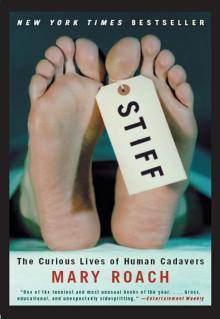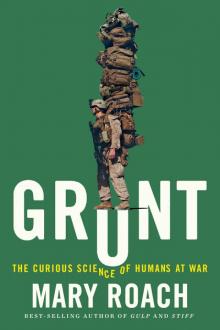- Home
- Mary Roach
Grunt: The Curious Science of Humans at War Page 3
Grunt: The Curious Science of Humans at War Read online
Page 3
The garments arrived on the first of December 1908. Whereupon the setbacks began. Four-fifths of the underwear was too tight for all but the smallest men. Perhaps, having seen the destination of the shipment, the clothiers had misunderstood and fashioned the items for the slighter, trimmer bottoms of the Filipino male. Perhaps they were cutting corners. Who can say. Six hundred men were dropped from the study. Worse, the underpants had been sewn from heavy dungaree cotton, causing the men to perspire in places where no one wants to perspire, surely counteracting any mystical cooling properties that the color might have conferred. The sweating proved doubly vexing, as the dye ran badly. Much joshing and ridicule—“bantering by their companions”—ensued. Over a month of washings, the red underwear progressed to yellow and onward to a “dirty cream color.” The cap liners, though less frequently laundered, ran in the rain or when the men sweated, causing red blotches and rivulets running down their faces and yet more bantering.
At the end of a year, the men were interviewed about their experience with the special underwear. Only 16 of 400 had anything positive to say. The red underwear was hotter and scratchier. It “outraged the sensibilities of the wearer.” In addition to prickly heat and rashes and a higher rate of heat exhaustion, it was blamed for headaches, dizziness, fever, blurred vision, boils, and colic. “An Experiment with Orange-Red Underwear” was read aloud at a biennial meeting of the Far Eastern Association of Tropical Medicine, no doubt jollifying the usual assortment of malaria and foot fungus reports.
While we are on the topic of hot, uncomfortable military intimates, a word about Kevlar underwear. A version of which was successfully marketed to the British Army: Blast Boxers††—protection against life-altering injuries.
“There was some controversy over this,” Accetta says.
LaFleur’s large, beautiful eyes widen. “She’s recording you.”
“Which I started.”
Fox News had called, asking why the Brits had bombproof underpants and our guys didn’t. “No such thing,” Accetta told the reporter. He said they were working on something else, and then he got off the call and dialed the Natick ballistic protection guys. What in fact were they working on? Silk underwear, said the ballistics guys. No, really, they said. Unlike other naturally breathable textiles—cotton, say—silk doesn’t fragment and riddle a wound with bits of fiber that can seed infection. It’s surprisingly strong. Spider silk, specifically, has a better strength-to-density ratio than steel. (Natick at one time had a “spider room” in the basement of Building 4 and a team of scientists working to parse the unique protein structure of spider webbing in order to synthesize it.)
Despite its strength, silk doesn’t inspire confidence. Kevlar does that. People don’t realize that a khaki-weight Kevlar (or its newer cousins Spectra and Dyneema) doesn’t stop bits of metal packed into improvised explosives. For that you’d need fifteen to forty plies—far too heavy for underwear. What Blast Boxers stop is dirt and sand launched by buried bombs. That is important, because dirt carries fungi and bacteria that can cause deep-lying, hard-to-conquer infections in a wound. Blast Boxers are excellent. But they are most assuredly not, as the advertising material implied, bombproof. “Honestly,” Accetta says, “if the insurgents can make a bomb big enough to blow up a seventy-ton M1 tank, they can certainly make a bomb that’s going to blow up your underwear.”
___________
* Natick Labs and precursor the Quartermaster Subsistence Research Laboratory have extended shelf lives to near immortality. They currently make a sandwich that keeps for three years. Meat, in particular, has come a long way since the Revolutionary and Civil wars, when beef came fresh off cattle driven alongside the troops. During World War II, the aptly named subsistence lab developed partly hydrogenated, no-melt “war lard” and heavily salted and cured, extra-dry “war hams” that kept for six months without refrigeration and earned the not exactly over-the-moon descriptors “palatable and satisfactory.” I quote there the July–August 1943 Breeder’s Gazette, sister publication of the Poultry Tribune, a newspaper either about or for barnyard fowl.
† Misspelled as “Uoellette” on the Natick Building Inventory, and “Oullette” on the sign outside the building. Somebody burned for that one.
‡ I went on the National Electronic Injury Surveillance System to find you a figure for the number of burns caused each year by pantyhose. Alas, NEISS doesn’t break clothing injuries down by specific garment. I skimmed “thermal burns, daywear” until I ran out of patience, somewhere around the thirty-seven-year-old man who tried to iron his pants while wearing them.
§ Including the skin of children whose parents, like mine, collected the mercury from broken thermometers and put it in a plastic margarine tub for them to play with. The sixties sure were different.
¶ Is it possible for an organization to have enough hook-and-loop fastener concerns to merit a whole agenda? When that organization is the US Army, it is. The US Army has enough hook-and-loop fastener concerns to merit an entire Hook and Loop Task Group (a sub-subcommittee of the Combat Clothing Utility Subcommittee).
# Defense Department facial hair policy is so complex that the Army saw fit to create visual aids for identifying Unauthorized Male Mustaches and Unauthorized Male Sideburns. Grids are overlaid on drawings of faces with labeled letter points, A, B, C, D. No such aid or information is provided for unauthorized female or transgender facial hair, and I encourage all such enlistees to begin growing their Fu Manchus and muttonchops now.
** The Cold Weather Trigger Finger Mitten Insert, a component of the Extreme Cold Weather Mitten Set. As opposed to the Intermediate Cold Wet Glove or the almost fashionable-sounding Summer Flyer’s Glove.
†† Referred to casually as the “combat diaper” or “blast diaper.” But not “codpiece.” Possibly because codpieces likely had nothing to do with genital protection—or fashion, for that matter, or cod. C. S. Reed, writing in the Occasional Medical History Series of the Internal Medicine Journal, speculates that codpieces were worn to cover syphilitic buboes (swollen, inflamed lymph nodes) and the “bulky woolen wads” used to absorb the “foul and large volumes of mixed pus and blood . . . discharged from the genital organs.” It’s all speculative, because the fabric codpieces, the pus, and the woolens have all disintegrated in the intervening centuries. We do have Henry VIII’s suit of armor, which features a codpiece like the nose of a Cessna, but historians now say there’s no evidence the king had syphilis. The only thing I can say for sure is that Bubo (in Kuwait City) is an even less appealing name for an eating establishment than Bursa (San Francisco).
Boom Box
Automotive safety for people who drive on bombs
AS SOMETIMES HAPPENS IN rural America, someone has shot up a road sign. The sign—a right-turn arrow on a yellow background—stands on a paved lane along the edge of Chesapeake Bay. Given the gape of the hole and the fact that the road traverses Aberdeen Proving Ground, there’s a good chance it wasn’t made by a bullet. A proving ground is a spread of high-security acreage set aside for testing weapons and the vehicles meant to withstand them. In the words of the next sign up the road: Extreme Noise Area.
I’m headed for Aberdeen’s Building 336, where combat vehicles come to be up-armored—as the military likes to up-say it—against the latest threats. Mark Roman, my host this morning, oversees the Stryker “family” of armored combat vehicles. He’ll be using them for an impromptu tutorial in personnel vulnerability: the art and science of keeping people safe in a vehicle that other people are trying to blow up.
My extremely uneducated guess is that some sort of shaped charge hit that sign. A shaped charge is an explosive double whammy used for breaching the hulls of vehicles and harming the people inside them. The first blast propels the murderous package to its target. On arrival, the impact detonates a wad of explosives packed inside. The blast slams a metal disc positioned in front of the explosives. Combined with the weapon’s contour, the energy of the blast shapes the m
etal into an extremely fast, close-range projectile that can punch through the hull of an armored vehicle with little trouble. RPGs (rocket-propelled grenades) are the ones most people have heard of, though there are ever bigger, deadlier iterations. Defense Industries of Iran is said to have one that can push through 14 inches of steel. Shooting a traffic sign with a shaped charge is like using a leather punch on a Kleenex.
By and large, an army shows up to a war with the gear it has on hand from the last one. The Marines arrived in Iraq with Humvees. “Some of the older ones had canvas doors,” says Mark, who was one of those Marines. His hair has since gone silver, but he’s retained the ready, let’s-do-this physicality that the Marine Corps seems to impart. When I asked a question about a new blast-deflecting chassis, he grabbed some wheeled mechanics’ boards and we rolled beneath a Stryker and finished the conversation on our backs.
Early on in Iraq, the Army tried plating vehicles with MEXAS armor panels, which work well against heavy machine-gun fire. “We were like, crap,” Mark recalls. “This does not stop an RPG.” You might as well have armored your vehicle with right-turn signs. Another thought was to add tiles of reactive armor, a sort of exploding Pop-Tart affair. When an RPG hits it, the filling explodes. This outward-directed blast serves to negate the blast of the RPG—and any passing pedestrian. Given that much of the fighting during the first Iraq conflict took place in urban areas—and was ostensibly an effort to “win hearts and minds” among the populace—reactive armor would have been a poor choice.
Besides, something cheaper and simpler had been found to work. Mark rolls out from under and leads the way to another Stryker, this one in a hoopskirt of heavy-duty steel grating called slat armor. The nose of an incoming RPG gets pinched between two slats, which duds it. It’s like squeezing your nose to stop a sneeze: It either prevents the explosion from happening or blocks the expulsion of nasty stuff. Either way, it proved effective. Strykers would lumber back to base like up-armored hedgehogs, bristling with RPGs. Slat armor worked so well that Iraqi insurgents largely gave up on RPGs.
And switched to making bombs. Early on in the Iraq war, improvised explosive devices were hidden on the sides of roads. Since these IED blasts hit vehicles broadside, the Army responded by flanking them with armor plates and replacing windows with “Pope glass”—two-inch thick transparent armor of the type that keeps His Holiness whole on his own tours of duty. Better, but it left the machine-gun turret exposed. Platoons tried piling sandbags up there, but they’d burst apart and literally sandblast the gunner. More ballistic shielding was added.
And thus more weight. All the added armor had Humvee engines screaming and straining on the uphills, and brakes burning out on the downs. Safety modifications on the Strykers added 10,000-plus pounds—far more than the vehicle was built to handle. You can beef up the suspension and tires, replace the engine—all of which was done—but you’ve still got problems. Past a certain tonnage, an armored vehicle begins to Godzilla the landscape. It breaks up asphalt, collapses levees. Exceeds the cargo capacity of the planes that deliver it. For every piece of armor and reinforcement, people like Mark would be called on to ditch something of similar weight. And the Stryker was never a lushly appointed vehicle. There is no onboard toilet. (There are empty Gatorade bottles.) The early ones didn’t even have air-conditioning. I tell Mark I’m glad to see some cup holders were left in place. I recognize the brief, polite silence that follows. It’s Mark Roman rendered mute by the fullness of my ignorance. They’re rifle holders.
Fast-forward to Afghanistan: land of the hundred-pound IED. To get around the up-armoring, insurgents came at vehicles from below, burying the explosives in the middle of the road rather than on the sides of it. As on most trucks, the chassis on US combat vehicles at that time were flat. Where newer generations of vehicles have V-shaped or double-V-shaped chassis to deflect the energy unleashed in a blast, the flat ones took it head-on. And because the seats were bolted to the passenger compartment floor, the energy would transmit directly to passengers’ feet, spines, and pelvises. Smacked them bad.
Newer vehicles have higher clearance. The force of a blast diminishes rapidly as it radiates outward. The energy at one or two feet is still so condensed that it can act like a solid projectile and break through vehicle floors. Once the integrity of the hull is breached, any loose piece of vehicle or gear becomes a projectile. Soldiers and Marines would pile sandbags on the floors of Humvees for the same reason aviators used to sit on their body armor instead of wearing it. Because death came up from below.
The underbody blast scenario was dire enough that US Central Command rolled out the procedural big guns: They issued a JUON (say, joo-on): a Joint Urgent Operational Need Statement. The statement surely ran longer than fifteen words, but the gist was this: Get us some combat vehicles that can drive over bombs and keep everyone inside alive. Nine vendors submitted prototypes for what would come to be known as MRAPs (say, em-wraps): mine-resistant, ambush-protected. But without fielding them first, how do you know which one is safest—and precisely how safe it is? You hire a “personnel vulnerability analyst.”
The Army Research Laboratory snapped up Nicole Brockhoff, premed at Johns Hopkins, with a graduate degree in biodefense. The youngest person to win the Secretary of Defense Meritorious Civilian Service Award. Bench presses 190. She’s come down from her office in the Pentagon to attend to some things, and agreed to make me one of them. Whenever Mark takes over the explaining, Brockhoff drops back and takes out her phone. She does not seem rude, just grindingly busy and determined to stay on top of her day. I see her come and go in my peripheral vision, pacing, answering email. She gives the impression of someone for whom idleness is almost physically unbearable. She is gorgeous, articulate, fast-moving, powerful. Lesser humans left blinking in her wake.
Brockhoff offers to show me another anti-IED modification: the energy attenuating seat. We climb inside the passenger compartment of a Stryker infantry carrier, which does not have a door but rather a drop-down ramp, like a circus boxcar. The first good thing about these new seats is that they are no longer bolted to the floor. Second, they ride on special shock-absorbing pistons. What’s special are the collapsible, replaceable metal inserts that slow the seat’s downstroke and keep it from bottoming out. The catch is that in order for passengers to protect their feet and lower legs, they need to keep them off the floor. The footrests on the base of each seat are for the person sitting directly across. Meaning that one soldier has to straddle the other’s knees for hours at a time. Mark, who has joined us, adds that having the knees up like that tends to make the butt go numb. “Like when you’re reading on the toilet too long. And you get toilet palsy.”
The last two words hover, finding nowhere to touch down. “Man thing,” Brockhoff decides.
On a long drive, fighters’ feet surely stray from the safety of the footrests. But their commanders likely know which parts of the route are riskiest and can give a heads-up.
Speaking of heads and up, I ask about airbags on the ceilings, to prevent brain injury. Unfortunately, automotive airbags don’t respond quickly enough to get the jump on a blast. Early on in her tenure at the Pentagon, Brockhoff found herself talking to a general about the challenges of high-speed energy mitigation. He suggested she talk to NASCAR.
“I said, ‘With all due respect, General. . . .’” The bottom of a personnel carrier is traveling many, many times faster than a NASCAR race car. And unleashing a force of many times greater magnitude. Besides, NASCAR’s approach won’t work for combat vehicles. Race car drivers are packed in their seats like mail-order stemware. Heads are braced and supported, so necks don’t break and brains don’t ricochet against skulls. Danica Patrick can’t even look out the driver-side window and wink at the pit crew. That’s no good for combat vehicles. Drivers and gunners need to be scanning in all directions, looking out for suspicious elements: piles of trash or dead goats that might be hiding bombs, people holding cell phones that might be wire
less detonators, children with their fingers in their ears.
At the same time that the Army was working to make existing vehicles safer, they were scrambling to evaluate the new MRAPs. When Brockhoff arrived, her colleagues were using the crash test dummy that the auto industry uses: the Hybrid III. First, because that’s what there is. And second, because it makes some sense. Both a car crash and an underbody blast cause blunt force trauma: the sorts of injuries you get from slamming into pieces of a vehicle’s interior. (As opposed to injuries caused by a blast pressure wave passing through you—rupturing organs and eardrums and the like—which a vehicle largely protects against.)
Here’s the problem: automotive crash test dummies were designed for measuring force mainly along two axes—front to back (for head-on impact), and side to side (for “T-bone” crashes). With a blast coming up from below, the axis of impact runs vertically through the body: heels to head. “This doesn’t,” Brockhoff told her colleagues gently, “seem like it’s going to be sufficient moving forward.” To make the point, a Hybrid III was filmed alongside a cadaver in a controlled blast. It is clear, from the slow-motion footage, that this dummy wasn’t built for this. It’s like watching an elderly, arthritic man try to follow along in a Zumba class. Compared with the flailing arms of the cadaver, the dummy’s barely move. When the real head comes down, the dummy’s is coming up. Its thighs rise a third as high off the seat as the cadaver’s, and its ankles barely flex.
The Hybrid III captures the basic pattern of injury—feet, lower legs, spine—but it doesn’t provide the level of detail Brockhoff’s team needed. “We were missing a lot of nuance about the severity of the injury. We needed to know, at what point do you go from a treatable injury that’s recoverable to something life-altering and incapacitating and potentially fatal? We need to be able to make those distinctions when we’re testing these trucks. And we can’t right now.”

 Stiff
Stiff My Planet: Finding Humor in the Oddest Places
My Planet: Finding Humor in the Oddest Places Gulp: Adventures on the Alimentary Canal
Gulp: Adventures on the Alimentary Canal The Best American Science and Nature Writing 2011
The Best American Science and Nature Writing 2011 Six Feet Over: Adventures in the Afterlife
Six Feet Over: Adventures in the Afterlife Packing for Mars: The Curious Science of Life in the Void
Packing for Mars: The Curious Science of Life in the Void Grunt: The Curious Science of Humans at War
Grunt: The Curious Science of Humans at War